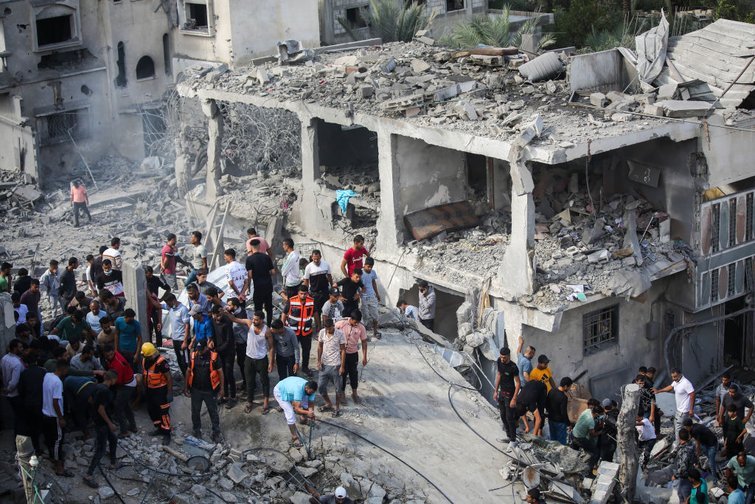As the Israel-Gaza conflict reaches its 496th day, the region remains engulfed in one of the longest and most devastating wars in recent history. The conflict, which began on October 7, 2023, has resulted in massive casualties, displacement, and international outcry, with no clear resolution in sight. What started as a large-scale attack by Hamas on Israel has since escalated into a prolonged military operation, drawing in various regional and global players.
The Onset of the War
On October 7, 2023, Hamas launched an unprecedented offensive against Israel, firing thousands of rockets while militants crossed the border into Israeli territory. This surprise attack resulted in significant civilian casualties and the abduction of numerous hostages, prompting Israel to declare war and retaliate with full force. The following weeks saw relentless airstrikes on Gaza, targeting key Hamas infrastructure and military positions.
By late October 2023, the Israeli government escalated its response, initiating a full-scale ground invasion of Gaza on October 27. The aim was to dismantle Hamas’ military capabilities, secure the release of hostages, and neutralize any future threats. However, as Israeli troops pushed deeper into the region, urban warfare intensified, leading to catastrophic civilian casualties and the displacement of millions.


Casualties and Humanitarian Crisis
The war has taken a severe toll on the people of Gaza, with reports indicating over 41,000 deaths and tens of thousands injured. The humanitarian crisis has reached alarming levels, with nearly 1.9 million people displaced from their homes. The destruction of hospitals, schools, and essential infrastructure has exacerbated the suffering, leaving civilians without access to medical care, clean water, and food.
International organizations have repeatedly called for ceasefires to allow humanitarian aid into the region. However, temporary truces have been short-lived, often collapsing due to renewed hostilities. The blockade imposed on Gaza has further restricted the entry of essential supplies, worsening the dire situation for those trapped in the conflict zone.
Israel’s Military Strategy and Key Developments
Israel’s strategy has focused on eliminating Hamas leadership and dismantling its military infrastructure. Targeted airstrikes have taken out several high-ranking Hamas officials, including Yahya Sinwar, one of the group’s most influential leaders, who was reportedly killed in an Israeli operation. Despite these efforts, Hamas has continued to resist, utilizing a network of underground tunnels and launching counterattacks.
Urban warfare in Gaza City and other densely populated areas has proven to be one of the most challenging aspects of the conflict for the Israeli military. The close-quarters combat has led to significant losses on both sides, with Hamas leveraging its deep knowledge of the terrain to carry out ambushes and hit-and-run attacks.
Israel has also faced increasing pressure domestically, with protests and public outcry over the fate of the hostages taken by Hamas. Families of the captives have urged the government to prioritize their release, leading to negotiations mediated by international actors. While some hostages have been freed in exchange for Palestinian prisoners, many remain in captivity, adding to the tension.
Regional and International Implications
The war has not remained confined to Gaza, as regional actors have been drawn into the conflict. Hezbollah, based in Lebanon, has engaged in periodic clashes with Israeli forces along the northern border, raising fears of a broader regional escalation. Iran, a key supporter of Hamas, has issued warnings and intensified its rhetoric against Israel, further complicating the situation.
Globally, the conflict has sparked massive protests and divided public opinion. While Israel has received unwavering support from some Western allies, particularly the United States, it has also faced criticism for its military actions and the high civilian death toll. Reports of potential war crimes have led to calls for international investigations, putting Israel’s leadership under scrutiny.
The United Nations and humanitarian organizations have continued to push for diplomatic solutions, but repeated efforts to broker a long-term ceasefire have failed. While temporary ceasefires have been negotiated at times to facilitate the delivery of aid or prisoner exchanges, they have not led to lasting peace.
The Future of the Conflict
As the war enters its 496th day, there are no clear signs of resolution. Israeli leadership remains determined to continue its military operations until Hamas is completely neutralized, while Hamas and its allies vow to resist. The people of Gaza continue to suffer, with little hope of immediate relief.
The long-term implications of this conflict are profound. The destruction in Gaza will take years to rebuild, and the political landscape of the region has been permanently altered. The war has also deepened divisions within Israeli society, with ongoing debates about security policies and the future of the Palestinian territories.
For now, the world watches as the war rages on, hoping for a breakthrough that could bring an end to one of the deadliest conflicts of the 21st century. Whether through diplomacy, military action, or international intervention, the resolution of this war will shape the future of the Middle East for generations to come.
Do follow Uae stories for more Updates













